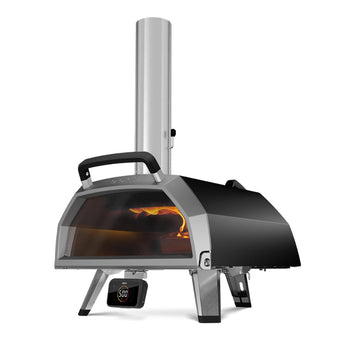While it’s impossible to declare that any particular style the best, one of the most beloved and hard to resist is a thin and crispy pizza. Depending on where you are in the world, you’ll come across various iterations of this pizza. We’ve decided to share three distinct and delicious styles: flammkuchen from Germany and France; New York-style from the US and finally, pizza tonda from Italy. Read on for a bit of history, tips and links to recipes to help you make these thin and crispy pizzas at home.
Traditional Flammkuchen
“Flammkuchen,” otherwise known as a tarte flambée or flame cake, is a Franco-German favourite. Although, who actually invented Flammkuchen is a hotly contested debate. Bakers in the Alsace region of northeastern France and the southwestern Palatinate region of Germany supposedly tested the heat of their wood-burning ovens with thin pieces of dough topped with crème fraîche. When the dough came out crisp, the ovens were ready to use.
Traditionally, this pizza has a thin, crispy base that’s denser than regular pizza dough. Ooni ambassador and owner of Finland-based, New York-style slice shop Slicemonger, Jukka Salminen (@slicemonger) created this flammkuchen recipe in one of our ovens. Honoring its flame-cooked roots and humble ingredients, including crème fraîche, bacon lardons and onions, this pie is rich, tangy and sharp.
New York-Style Pizza
Pizza in New York City is as diverse as its residents. It’s hard to argue any of the myriad styles found in the city are more iconic than the classic New York-style pie with its large (anywhere from 18 to 24-inches-wide) and sturdy base topped with tomato sauce, plenty of low-moisture shredded mozzarella, and sold, usually, by the slice.
The history of pizza in New York City is rich and extensive. Founding cornerstones include Lombardi’s in Little Italy, Totonno's in Coney Island, John's of Bleecker Street in Greenwich Village, and Patsy's in Harlem. Traditionally, New York pizzerias cooked their pizzas in coal ovens. Eventually, gas ovens became dominant, and that paved the way for the proliferation of pizza shops for which New York is famous today.
Traditional Italian styles of pizza (like Neapolitan pizza) often rely on the aggressive heat and flame found in a coal or wood-fired oven. New York pizza-makers adapted these recipes so that they could make more consistent pizzas at lower temperatures. The trade-off being New York-style pizzas require a bit longer to bake.
Our recipe is a nod to today’s classic New York cheese pizza, using bread flour enriched with olive oil and sugar, cold-proofed overnight, and baked low and slow. The sauce, cooked over low heat, is thick and rich. Less moisture in the sauce helps retain a sturdy crust, and the addition of sugar and oil provides a silky texture and flavour to balance the generous serving of low-moisture mozzarella.
Roman-Style Pizza
Rome is most well-known for two styles of pizza: pizza al taglio and pizza tonda. Pizza al taglio has a focaccia-like base, is sold by the slice and charged by weight, while pizza tonda is a round pizza with a super-thin and crispy base. Inspired by a trip to Rome, Ooni Co-CEO, Kristian, developed a recipe for a pizza bianca, or white pizza. To get that distinctive crunch, his version is cooked at a low temperature for a longer period of time, and believe us–those extra minutes are worth it.







